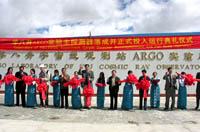Central Carpet of YBJ-ARGO Experiment Hailed Completion
 The YBJ-ARGO Experiment based at Yangbajing (4300m a. s. l.), Tibet, P. R. China, is a collaboration between China and Italy supported by MOST, NSFC, CAS, China and INFN, Italy. The main detector consisting of 130 clusters (called the Central Carpet, one cluster consisting of 12 Resistive Plate Chambers, one chamber being further divided into 10 detector units) was completed and put into full operation in June 2006. Under the trigger multiplicity of 20, the event rate is greater than 3KHz with the data rate ~350GB/day. The inconsistency of the clusters is less than 5%. Two years of continuously monitoring of the single rates showed very good stability.
The YBJ-ARGO Experiment based at Yangbajing (4300m a. s. l.), Tibet, P. R. China, is a collaboration between China and Italy supported by MOST, NSFC, CAS, China and INFN, Italy. The main detector consisting of 130 clusters (called the Central Carpet, one cluster consisting of 12 Resistive Plate Chambers, one chamber being further divided into 10 detector units) was completed and put into full operation in June 2006. Under the trigger multiplicity of 20, the event rate is greater than 3KHz with the data rate ~350GB/day. The inconsistency of the clusters is less than 5%. Two years of continuously monitoring of the single rates showed very good stability.
The celebration ceremony was held in Lhasa on 26 June 2006, with distinguished guests from the local government, IHEP, INFN, NSFC, CAS, Italian Embassy to China. On the ceremony the Chinese Side of the Collaboration reported the cooperation and organization of ARGO Experiment both in China and abroad, its progress, physics analysis. The guests fully approved the hard-working spirit of ARGO Collaboration Group in spite of the plateau conditions, and spoke highly of good performance of the Carpet as well as the leading role of Chinese Side in the Experiment. ARGO’s operation as next step and physics analysis was greatly expected. 
With the ARGO experiment starting its mass detector installation at the second half of 2004, the Chinese and Italian components strengthened their collaboration and coordination on the schedule together with the production and supply of the key materials which greatly speeded up the job. Six Chinese installation teams have been sent to Yangbajing which installed more than 100 clusters (80% of the total) while the left were completed under the collaboration. Due to the huge number of detector units, manual calibration of the detectors is a great difficulty. A new offline detector calibration method (named the Characteristic Plane method) was developed which successfully solved the problem (with calibration accuracy better than 0.4ns which fully meets the experimental requirement). Since ARGO is producing a huge amount of online data, a recoding method was developed by the Chinese side reducing the raw data to one-third of the online one, which will save about 2M RMB per year for each side. A 155Mbps network link from Yangbajing to IHEP was established to transfer the raw data to IHEP with daily synchronization providing the physicists a more effective way than tape transportation to do the analysis in time. An IHEP-centered operational network was setup for experts to control and monitor the running of the carpet remotely. During the installation, the Chinese component assumed both the detector performance study and data checking under which problems are found and solved in time providing the collaboration clean and reliable data.